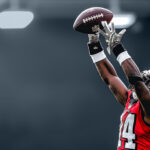Overuse injuries, (chronic injuries) are a category of sport-related injuries that result from cumulative trauma or repetitive use and stress. Overuse injuries are often found in low-contact sports that involve repetitive movements.
Females are typically at higher risk of overuse injury than males: One study that examined injury rates in 16 Division I NCAA sports found highest overuse injury rates occurred in women’s soccer, hockey, volleyball and softball. Chronic overuse injuries are responsible for a substantial amount of time loss for athletes across sports, however, risk factors that predispose athletes to incur overuse injuries are, to an extent, more controllable (through effective management/monitoring) than acute/contact injuries. Additionally, managing and monitoring the factors that increase an athlete’s risk of overuse injury largely transfer to reducing likelihood (or at least severity) of acute injury incidence.
What is an overuse injury?
Overuse injuries are associated with a gradual increase in symptoms and athletes may be unaware that they are seriously injured. Thus, overuse injuries may present not only physical but also psychological challenges that could significantly affect an athlete’s recovery and performance. If undiagnosed and untreated overuse injuries can produce long-term residual symptoms and health consequences (e.g. arthritis). A range of overuse injury risk factors have been identified in research (physical, psychological, physiological) and triangulated from an applied perspective: 34 medical directors working in UEFA participated in a recent research study to investigate perceptions of injury risk; previous injury, subjective well-being and objective workload were considered key variables that increased athlete’s risk of sustaining an injury during training or match scenarios.
Impact of overuse injury
Like in many professional sports leagues, overuse injuries incur substantial performance debt in the NCAA. This is in addition to the traumatic effect to these individuals of potential loss of entire seasons of sports participation and possible scholarship funding, significantly lowered academic performance (Freedman et al. 1998). Unfortunately, monitoring overuse injury risk factors remains unstandardised in collegiate sport. Whilst progress is evident in tracking injury incidence, standardised risk factor monitoring is surely required if reducing overuse injury in the NCAA is the objective.
Strategies for prevention of and early intervention with overuse injuries are needed to reduce the number and severity of overuse injuries. As is the case across other scientific domains domains, theory-derived best practices often are not reflective of actual procedures employed in the field due to practical constraints e.g., athletic trainers often rely on subjective or proxy objective (outcome) measures of musculoskeletal function when perceived ‘gold standard’ procedures require extensive equipment or specialist training/expertise. Thus understanding and balancing the challenges inherent in transferring scientific knowledge to practical application is an essential precursor to understanding how to optimise overuse injury monitoring strategies.
Tracking risk factors to reduce overuse injury
Physical Risk Factors:
As discussed in previous blog posts (e.g. FMS, ACL injury) maladapted movement patterns can increase overuse injury risk. Asymmetry within movement patterns (i.e. kinetic chain imbalance) or between limbs increases the risk of injury due to inefficient neuromuscular recruitment and/or ground reaction force dispersion. During sports-skill execution, ground reaction force increases to 3-6 times body weight. Maladapted movement patterns and asymmetry can increase ground reaction force considerably. Impaired ability to attenuate ground reaction force can alter length-tension relationship in kinetic chains and increase the stress placed on cartilage, ligaments etc. and subsequently increase the risk of injury or strain due to overload of the limb/joint.
Psychological Risk Factors:
In addition to the physical risk factors predisposing athletes to injury, a number of psychological precursors increase individuals risk of sustaining an injury. Most notably, perceived well-being (mood/stress/fatigue/soreness) indicate whether athletes are at risk of developing injury. These factors can be explained through endocrinological operating mechanisms whereby increased cortisol or creatine kinase and decreased adrenaline and dopamine suppress athletes psychological status and decrease the body’s capacity to respond to and recover from training demands. Continuing to train with suboptimal endocrinological profiles increases athlete’s’ risk of injury. Hydration, sleep quality and stress load have been correlated with an athlete’s risk of developing an overuse injury.
The RPE evaluation requires the athletes to use a combination of feedback from cardiorespiratory, metabolic and thermal factors as well as feedforward mechanisms (feelings, thoughts, perceptions) to evaluate how hard or easy an exercise task feels at any point in time (Gianluca, Vanda & Cecelia, 2014). RPE readings correlate with heart rate, oxygen uptake and blood lactate levels, particularly for dynamic activity. Objective measures of load experienced by players (e.g. GPS) tracks training/game markers, however player response to load is lost when relying solely on objective methods. Subjective rating i.e. RPE is moderated by psychological aspects (e.g. cognition, memory, previous experience, understanding of the task, fatigue, emotion) and situational features (e.g. knowledge of the task outcome, time-based characteristics of the exercise, interaction between athletes) (Brink et al, 2014). Drawing upon the knowledge from cognitive and sports psychology, athletes’ perceptions of susceptibility to injury have a tangible impact on the likelihood of actually sustaining an injury. RPE provides a practical method of linking perceived and actual workload/well-being status for athlete monitoring.
Physiological Factors
Sports workload balance is defined by the point where cumulative stress result in maximal gain (fitness/strength etc.) and minimal loss (stress/fatigue/injury). Workload sustained by athletes can vary across sports and across sub-domains of training within sports (agility, fitness, gym, pitch etc.). Thus monitoring workload in practice typically employs a system of arbitrary units (AU) to allow comparative analysis of the overall training load for athletes. Such systems enable coaches and support staff to periodise training, recovery and adaptation appropriately. To reduce the risk of injury, derived training and game load values (weekly loads and previous week-to-week load changes) should be individually monitored. Typically both acute and chronic training loads are tracked. Specifically, changes in acute and chronic load (i.e. too much or too little training) can increase an athlete’s risk of injury. As discussed in the psychological risk factor section, in addition to external demands imposed by game/training, an individual’s ability to adapt to training stimuli will impact on how much is too much (or too little) in sports. Thus when monitoring workloads, tracking squad specific loadage is necessary, but monitoring individual responses to training stimuli is essential to understanding the actual impact of physical and psychological stresses accrued through training/competition.



 More than Equal’s mission is to close the gender gap in motor sports and find and develop the first female Formula 1 world champion. They will now have an advanced operating system to centralize data for female drivers participating in More than Equal’s pioneering Development Programme.
More than Equal’s mission is to close the gender gap in motor sports and find and develop the first female Formula 1 world champion. They will now have an advanced operating system to centralize data for female drivers participating in More than Equal’s pioneering Development Programme.